PROMO!
First order? Get 10% OFF with this code: 1storder
Our Product Categories
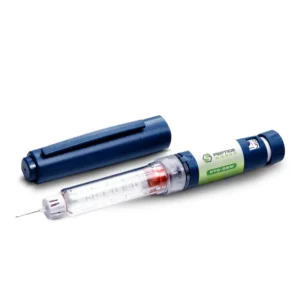

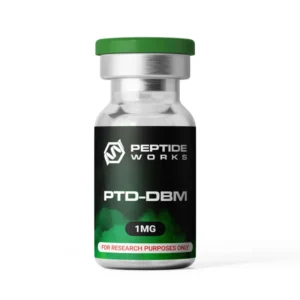
A protein transduction domain (PTD) and a disulfide-bond disrupting motif (DBM) are combined to create the synthetic fusion peptide known as PTD-DBM. By allowing the peptide to pass through cell membranes, PTD promotes cellular uptake, whereas DBM targets and breaks down protein disulfide bonds. PTD-DBM is a valuable tool in biomedical research.
It effectively studies cellular signaling pathways and protein-protein interactions, largely because of its dual functionality. By breaking disulfide bonds, PTD-DBM can change how proteins are structured and how they function. This ability suggests it could be useful in regenerative medicine, cancer treatment, and drug delivery. It is a valuable tool for advancing research in molecular and cellular biology due to its adaptability and specificity.
Peptide Sequence (IUPAC Condensed): H-Arg-Arg-Arg-Arg-Arg-Arg-Arg-Arg-Gly-Gly-Gly-Gly-Arg-Lys-Thr-Gly-His-Gln-Ile-Cys-Lys-Phe-Arg-Lys-Cys-OH
Molecular Formula: C124H22N61O28S2
Molecular Weight: 3082.65
Synonyms: Protein Transduction Domain-fused Dishevelled Binding Motif peptide, Hair Growth Peptide
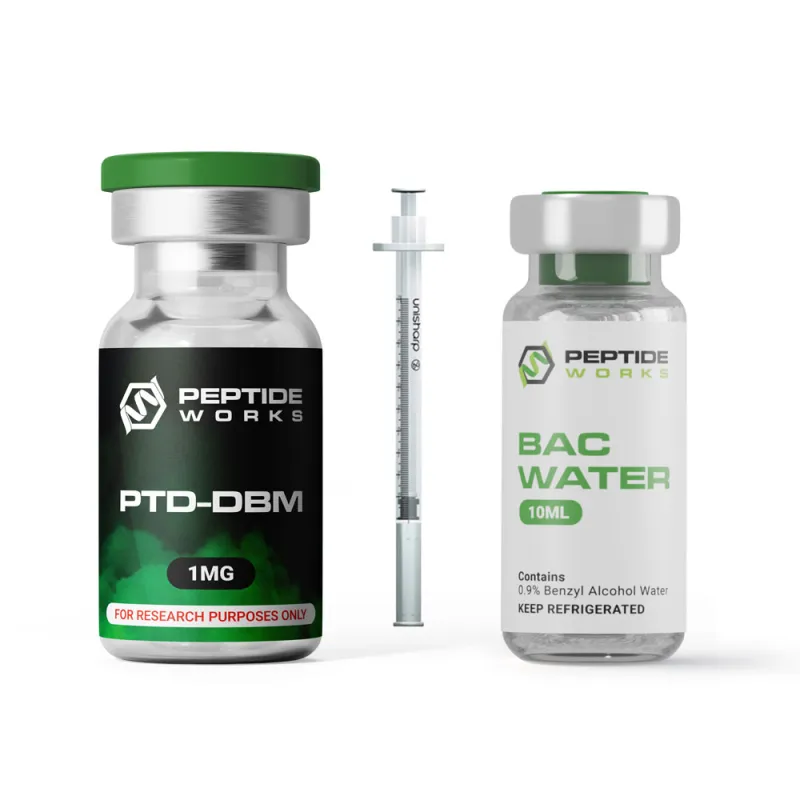
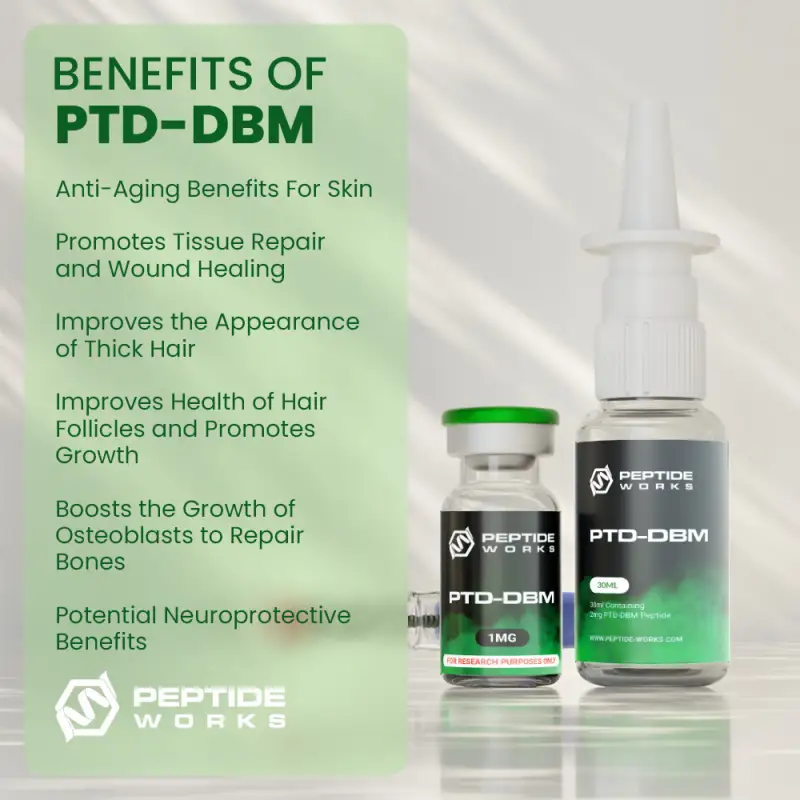
The PTD-DBM peptide operates through the synergy of its two functional domains. The peptide can effectively cross cell membranes thanks to the PTD component, guaranteeing intracellular delivery. Once inside the cell, the DBM domain targets protein disulfide bonds. Protein stability and structure depend heavily on disulfide bonds.
PTD-DBM modifies protein conformation by breaking these bonds, which may prevent or change the function of the protein. Research on signaling pathways, disease mechanisms, and protein folding benefits greatly from this mechanism. Moreover, PTD-DBM’s capacity to alter protein activity suggests potential for therapeutic uses, including the delivery of medications to particular intracellular targets or the targeting of cancer cells.
Regulates Cellular Signalling:Studies show that the PTD-DBM peptide regulates cellular signaling by inhibiting the interaction between CXXC5 and Dishevelled (Dvl). This disruption prevents CXXC5 from exerting its negative feedback on the Wnt/β-catenin pathway, thereby modulating the signaling process more effectively. The activation of Wnt/β-catenin signaling enhances processes such as collagen production and myofibroblast differentiation, which are crucial for wound healing.
Studies show that PTD-DBM accelerates cutaneous wound healing in mice, especially when combined with valproic acid (a GSK3β inhibitor). By disrupting the CXXC5-Dvl interaction, PTD-DBM promotes β-catenin activation, keratin synthesis, and collagen production, making it a promising therapeutic candidate for improving wound healing and addressing dermal fibrosis [1].
Stimulates Hair Growth and New Follicle Formation: Research shows that PTD-DBM peptide can stimulate hair regrowth and new hair follicle formation. It works by activating the Wnt/β-catenin pathway, which is crucial for hair development. PTD-DBM achieves this by disrupting the interaction involving CXXC5. CXXC5 is a protein that normally suppresses the Wnt/β-catenin signaling. High levels of CXXC5 are found in balding scalps and miniaturized follicles, contributing to hair loss [2].
In studies using rodent models for conditions like male pattern baldness (androgenetic alopecia) and wound healing, topical application of PTD-DBM significantly promoted hair regrowth and new hair follicle creation [3]. The effects were even stronger when PTD-DBM was combined with valproic acid, another substance that activates the Wnt pathway.
By specifically targeting this pathway, PTD-DBM offers a promising new approach for treating hair loss, as it helps both existing hair regrow and new follicles develop [4].
Promotes Wound Healing: Research indicates that PTD-DBM peptide promotes wound healing by activating the Wnt/β-catenin pathway through disruption of the CXXC5-Dishevelled interaction, which removes CXXC5’s negative feedback. In vitro, PTD-DBM increased β-catenin levels and downstream markers such as α-SMA and collagen I in dermal fibroblasts, enhancing fibroblast activation and myofibroblast differentiation.
In vivo, PTD-DBM accelerated cutaneous wound repair in mice, boosting keratin and collagen synthesis. Co-treatment with valproic acid, a Wnt pathway activator, further enhanced these effects. These findings highlight PTD-DBM’s potential as a therapeutic agent for improving wound healing and dermal repair by targeting the Wnt/β-catenin signaling pathway [1].
Potential Tissue Repair in Bone and Cartilage: Studies indicate that the PTD-DBM peptide, through its targeted action on the Dvl–CXXC5 interaction, holds promise for diverse regenerative therapies in both bone and cartilage. Mechanistic studies suggest that blocking CXXC5’s negative feedback on the Wnt/β-catenin pathway enhances osteoblast differentiation and bone formation.
Small-molecule inhibitors of this interaction have demonstrated bone anabolic effects in preclinical models, including enhanced osteoblast activity in vitro and bone regeneration in ovariectomized mice. These findings highlight the regenerative potential of targeting the Dvl–CXXC5 axis, suggesting PTD-DBM could play a role in tissue repair strategies for bone and cartilage, though further research is needed to explore clinical applications [5].
Buy PTD-DBM Peptide Nasal Spray from Peptide Works. The spray is available in 15ml and 30ml glass bottles, offering a simple and needle-free administration option.
[1] S-H Lee, M-Y Kim, H-Y Kim, et al (2015) The Dishevelled-binding protein CXXC5 negatively regulates cutaneous wound healing – Journal of Experimental Medicine, 2015 Jun 29, Volume 212 (Issue 7), Pages 1061–1080.
[2] Y Chan Ryu, J Park, Y-R Kim, et al (2023) CXXC5 Mediates DHT-Induced Androgenetic Alopecia via PGD2 – Cells, 2023 Feb 9, Volume 12 (Issue 4), Page 555.
[3] S-H Lee, S Hwa Seo, D-H Lee, et al (2017) Targeting of CXXC5 by a Competing Peptide Stimulates Hair Regrowth and Wound-Induced Hair Neogenesis – Journal of Investigative Dermatology, 2017 Nov, Volume 137 (Issue 11), Pages 2260-2269.
[4] B Young Choi (2020) Targeting Wnt/β-Catenin Pathway for Developing Therapies for Hair Loss – International Journal of Molecular Sciences, 2020 Jul 12, Volume 21 (Issue 14), Page 4915.
[5] H-Y Kim, S Choi, J-H Yoon, et al (2016) Small molecule inhibitors of the Dishevelled-CXXC5 interaction are new drug candidates for bone anabolic osteoporosis therapy – EMBO Molecular Medicine, 2016 Apr 1, Volume 8 (Issue 4), Pages 375-87.
The answers to the most frequently asked questions about PTD-DBM.
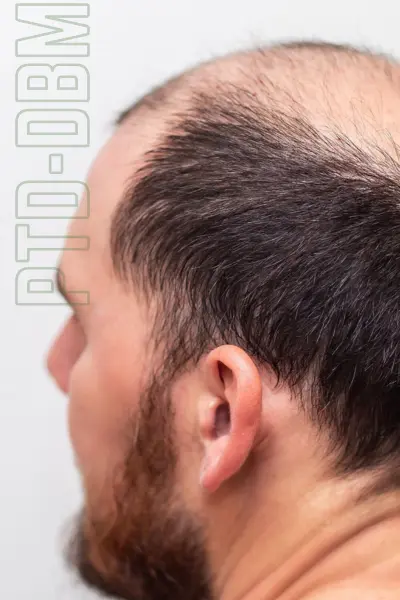
Buy PTD-DBM Pre-Mixed Peptide from Peptide Works. Each pen kit includes a 1mg pre-mixed cartridge, along with a cartridge pen, needle tips, and carry case for an easy and precise delivery format.
PTD-DBM stimulates hair growth by activating the Wnt/β-catenin pathway, a key signal that controls hair follicle activity. It blocks a protein called CXXC5, which normally stops this pathway and limits new hair growth. By preventing that blockage, PTD-DBM helps dormant follicles become active again, leading to the growth of stronger and thicker hair through the body’s natural repair and renewal process.
In research studies, PTD-DBM promoted new hair growth in animal models within about 12 to 20 days of topical use. The peptide works by activating the Wnt/β-catenin pathway and reawakening dormant follicles. However, no verified human data currently defines a specific timeline for results. Because PTD-DBM remains a research-only peptide, any expected timeframe is based on preclinical findings, not confirmed clinical outcomes.
PTD-DBM is not approved by the U.S. Food and Drug Administration (FDA) for medical or cosmetic use. In the United States, it is classified as a research-only peptide and is not authorized for human use or sale as a treatment. Current studies explore its potential role in hair growth and tissue repair but it has not yet undergone clinical testing. Regulations may differ by region or country, so approval status can vary globally.
PTD-DBM is available at Peptide Works, a trusted global supplier of premium research peptides. Our PTD-DBM is lab-tested for purity, quality and consistency, ensuring dependable results for advanced scientific research. We offer secure worldwide shipping and maintain strict storage and handling standards. Peptide Works is dedicated to providing researchers everywhere with high-quality peptides that support innovation and discovery.

In this blog, we take a closer look at the PTD-DBM Hair Growth Peptide and its potential to help fight balding by reducing follicle shrinkage and encouraging new growth. The discussion also covers TB500 and its part in tissue repair and blood circulation, showing how both peptides can support stronger, healthier hair over time.
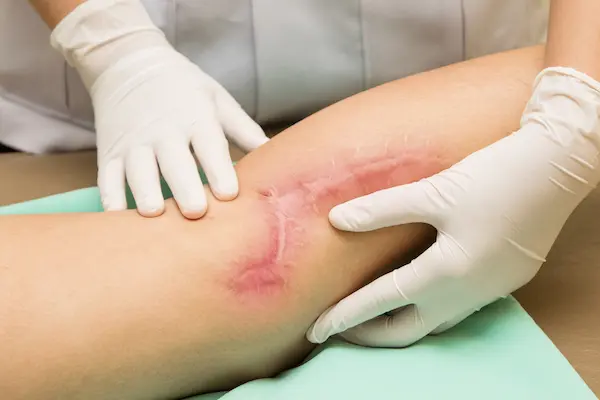
This blog looks at the role of peptides such as PTD-DBM, BPC-157, and GHK-Cu in supporting tissue repair and skin recovery. It discusses their influence on cellular healing, angiogenesis, fibroblast activity, and extracellular matrix remodeling. These peptides show promise in accelerating recovery, minimizing scars, and enhancing skin regeneration in regenerative medicine research.

This blog explores the science behind anti-aging peptides and their role in stimulating collagen, improving skin firmness and reducing wrinkles. It highlights key compounds such as GHK-Cu, PTD-DBM and SNAP-8, discussing their unique benefits, mechanisms of action and potential in skincare innovation while offering insights into the future of youthful, resilient skin.
ALL CONTENT AND PRODUCT INFORMATION AVAILABLE ON THIS WEBSITE IS FOR EDUCATIONAL PURPOSES ONLY.
DISCLAIMER: These products are intended solely as a research chemical only. This classification allows for their use only for research development and laboratory studies. The information available on our Peptide Works website: https://peptide-works.com/ is provided for educational purposes only. These products are not for human or animal use or consumption in any manner. Handling of these products should be limited to suitably qualified professionals. They are not to be classified as a drug, food, cosmetic, or medicinal product and must not be mislabelled or used as such.